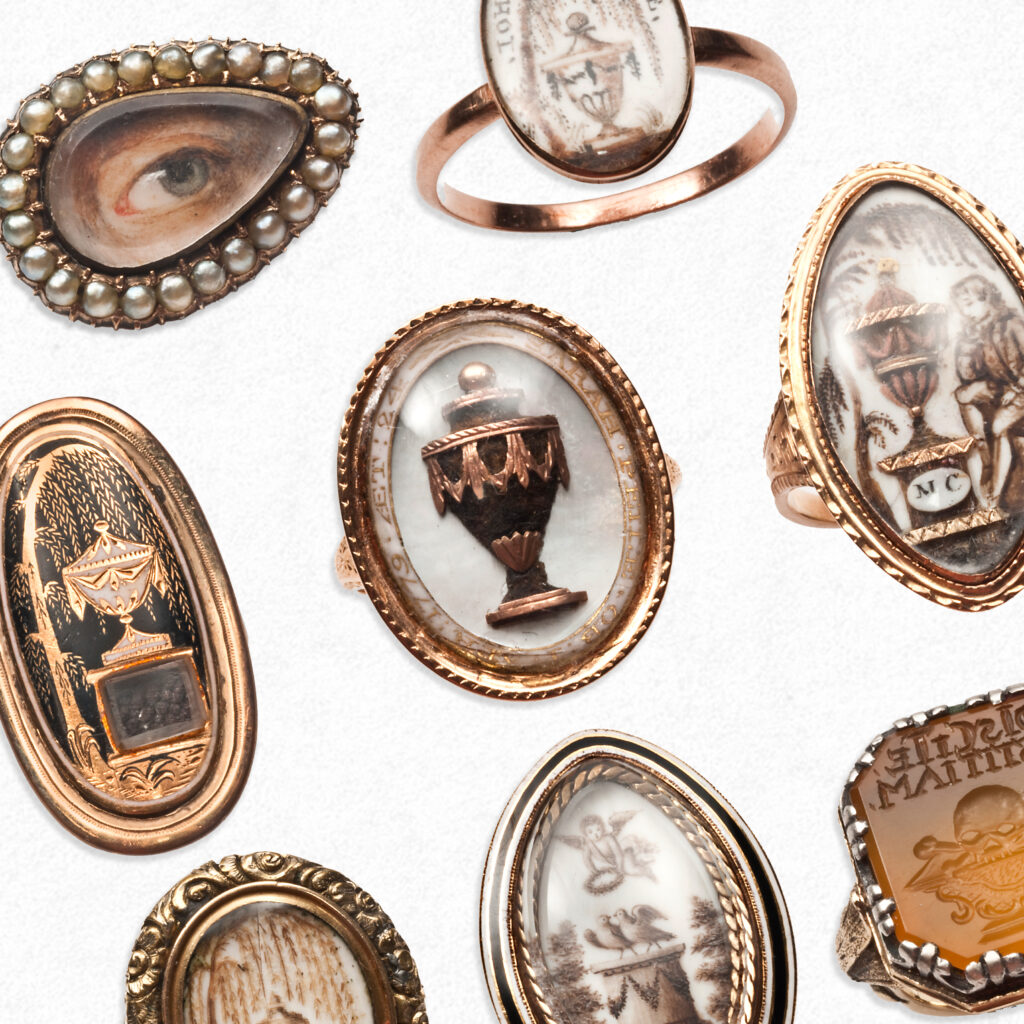Mourning Fashion in White
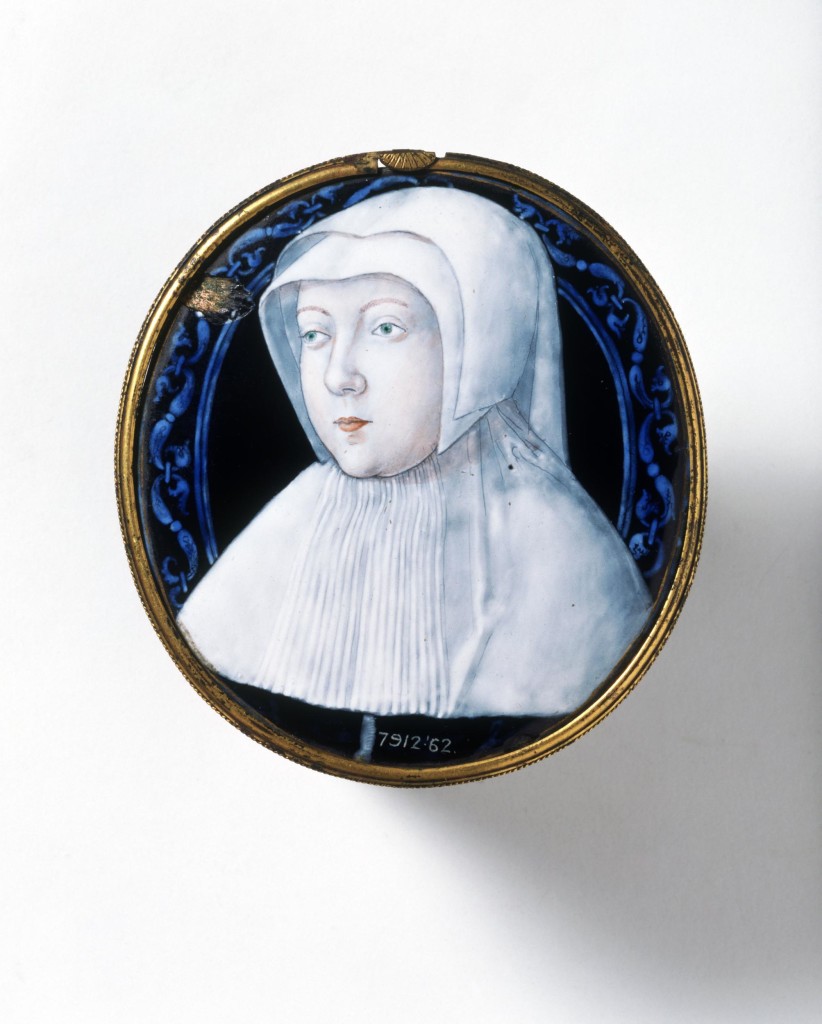
The affectation of white in mourning is ubiquitous, and appears throughout the world in funerary and mourning customs. White, the predominant colour used to symbolize the loss of children and the unmarried, was used in mourning fashion for young children, as well as accessories for women. Stages of mourning are important in the re-introduction of white into daily dress, as conventions changed between the 17th and 19th centuries. In the following examples, white as a part of mourning can be seen in daily fashion.
The modern mourning dress has its origins in the convents of the early Christian church. Wealthy widows established many of these convents as a place to retire from society and live in seclusion after the death of a husband. Similarities with nuns are clear; the rejection of a sexual lifestyle, dressing in black, grey and white to symbolize the loss of joy, while nuns would wear black, grey, brown and white to symbolise purity, humility and chastity. Sexual anonymity was present in both costumes, as well. Nuns would be be draped in fabric and hiding their faces, even to the point of shaving one’s head, rejected any interest in vanity. Similarly, widows were hidden under veils and drapery, wearing clothes that were out of fashion to represent their lack of interest in society. Habits changed depending on the faithful order, ranging from white dresses with black trim, to full black. Up to the early modern period, mourning costume would mimic secular styles, but would infuse modern and popular fashion. The establishment of the mourning dress in the popular mind was set; the widow’s weeds became the acceptable way to present the self in mourning after the death of a loved one.

Richard II’s funeral in 1400 is an early example of how the various colours of mourning in dress could be displayed. White, gold and black are utilised, showing that there was no formal standardisation by the 14th and 15th centuries. In this funeral cortege of Richard II leaving Pontefract Castle, a washed-out palette of colour used in the display of the mourners adds an anaemic and sad pall to the painting. At St Pauls, thirty torch bearers wore white and the conventions of a monarch’s death were the most direct and ‘proper’ of what a nation would try to emulate for the ideal way of mourning.
“To mourn inn black as a nationall a custome, as for the grave.” – Edmund Bolton, The Elements of Armories (London: [n. pub.], 1597
Like the French, English monarchs mourned in purple and not black as a way to separate them from the regular populace. During the Renaissance, the development of many of the customs that would solidify in the 17th century began. Colour association with death changed along with the message of mourning and the access to wealth that could accommodate the acceptable principles of mourning.

The importance of this miniature, painted by Hans Holbein in 1536 displays the standardisation of mourning costume and the adaption of colour in mourning costume. In funeral traditions, portraiture was only reserved for important figures and for the monarchy; it was a luxury not accessible for the middle and lower classes. This miniature steps outside of this court-only paradigm and presents Mrs Jane Small (née Pemberton), the wife of Nicholas Small, a prosperous London merchant. Painted on vellum, the subject wears a red flower and two ears of corn and holds a leaf. Her white cap, collar and shoulders contrast with her black dress,presenting the image of a fashionable woman in social mourning. Here, we see an excellent example of a daily mourning costume, worn outside of the court, due to the merchant class gaining enough wealth to invest in the arts. The more that a popular fashion could be disseminated through society, the more it could be adapted, leading to standardisation.
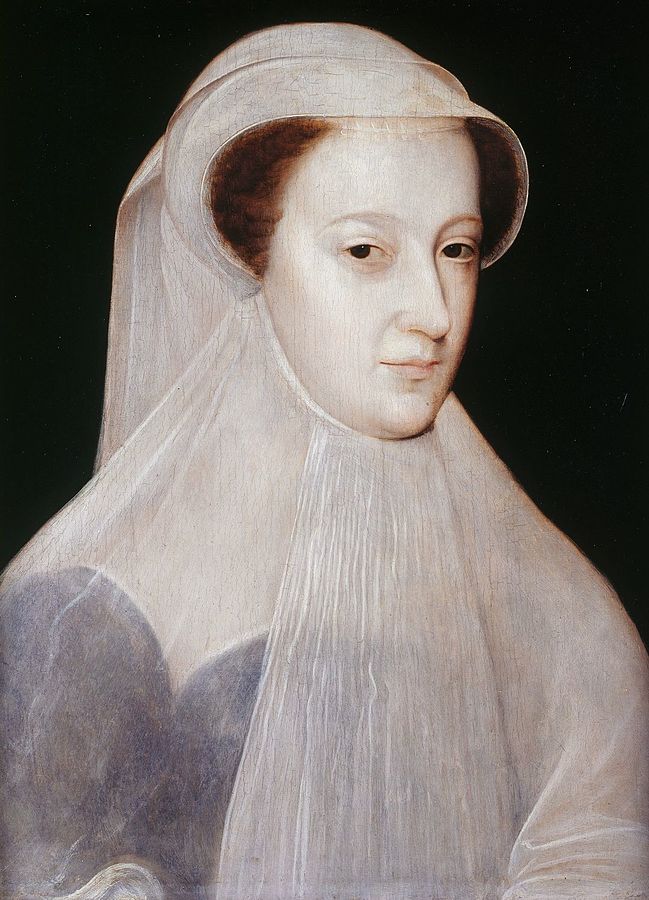
The cap remains one of the most typical mourning fashion items to be made in white. Earlier known as the ‘Paris heads’, the headdress was adapted from the French hood, or more famously recognised as the ‘Mary Stuart’ cap, as can be seen in her portrait above. This style of fashion was worn by all women in mourning during the 16th century, unless they were very poor. These caps weremade of closely fitted white linen, stretching down over the forehead. A panel of pleats would hang from the reverse of the cap.

Signed and dated 1624, this irregularly sized portrait depicts a the sitter wearing matt black fabrics, considered appropriate for mourning. The portrait is not a full sized portrait, nor is it a miniature, which is odd for the work of Cornelius Johnson, who painted it.
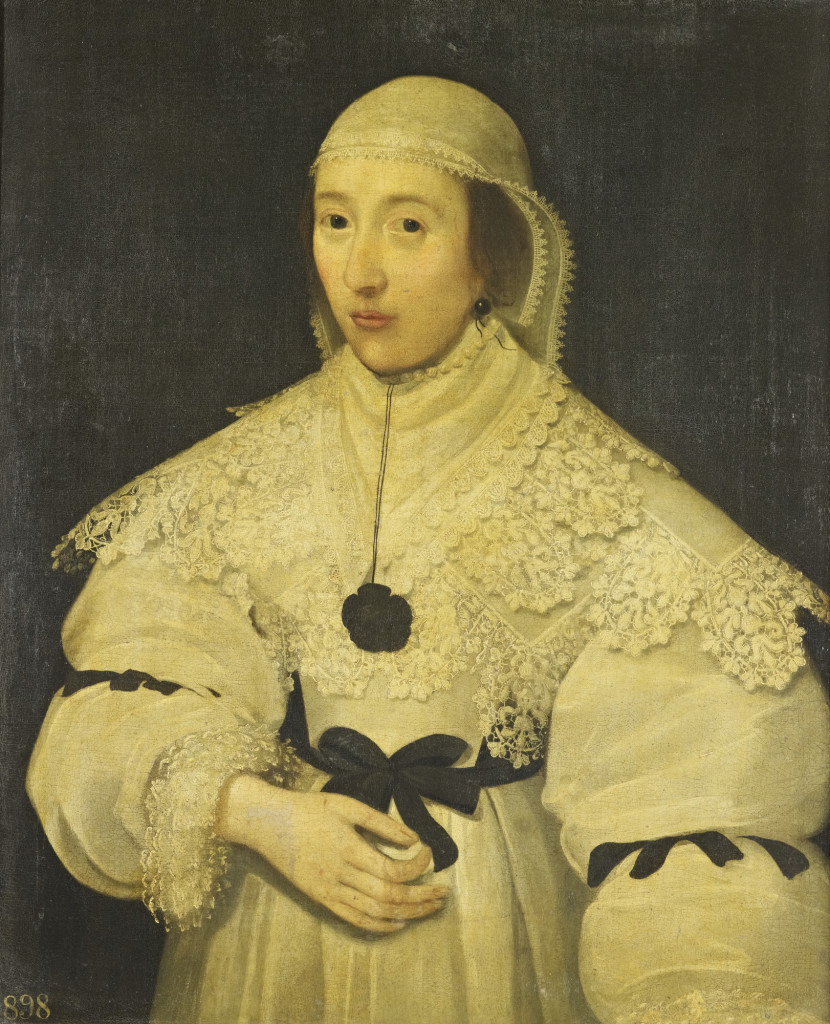
The lady’s ruff and bodice are white, with the black trim and detail being the secondary colour used in the dress. While this portrait is considered to be a lady in mourning, the fashion of the dress remains consistent with contemporary mourning costume. Black trim is an important factor in modern mourning fashion, being an addition to a white garment. The cost of buying new dresses for mourning, as well as the sentimentality that might be attached to another dress which could be dyed/amended to be repurposed for mourning, are factors in white remaining a primary colour through different stages of mourning.
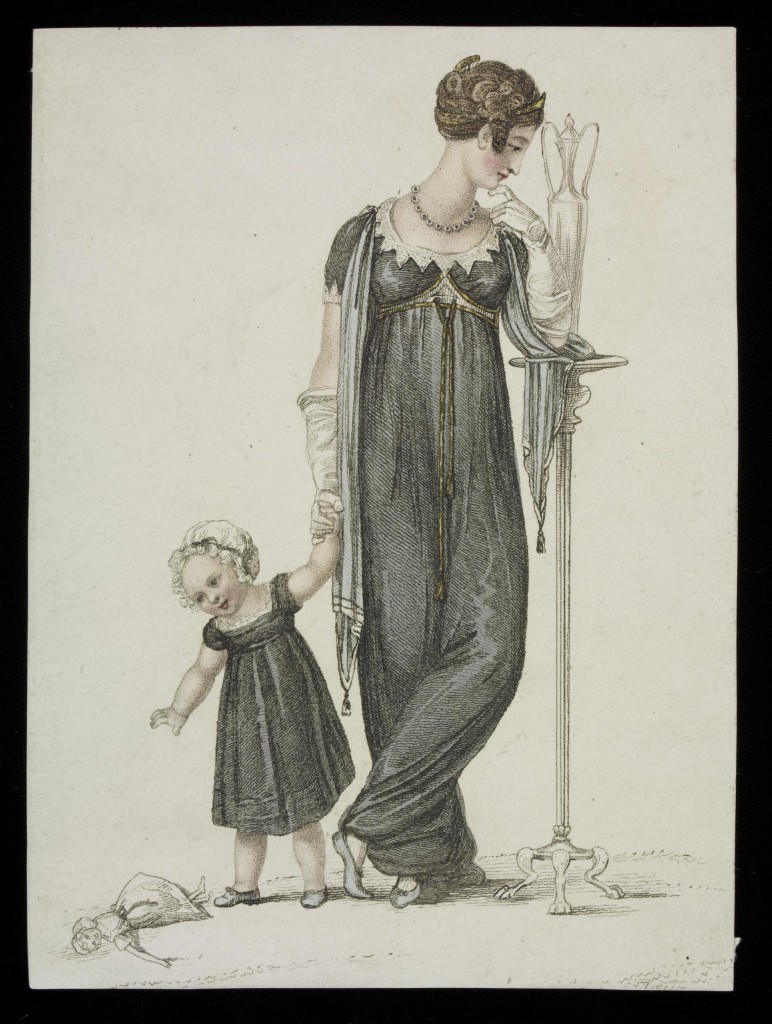
In this British fashion plate from 1809, we can see how fashion and mourning are linked. The Neoclassical style had permeated through society since its introduction in c.1760. Here, the mother and child are at the height of classically influenced fashion, known as the “Empire” style. Their high waistlines, fitted under the bust, along with their gathered skirts, gloves and curled hair, would be considered suitable items for evening wear. Even in the context of the urn design, this is highly stylised, being the aspiration of the fashion plate for a modern woman in mourning. Around the woman’s neck, the subtle black and white necklace design is the only addition of jewellery. An idyllic depiction, this is a balance for the black and white of the outfit, rather than a literal image of a woman in mourning.
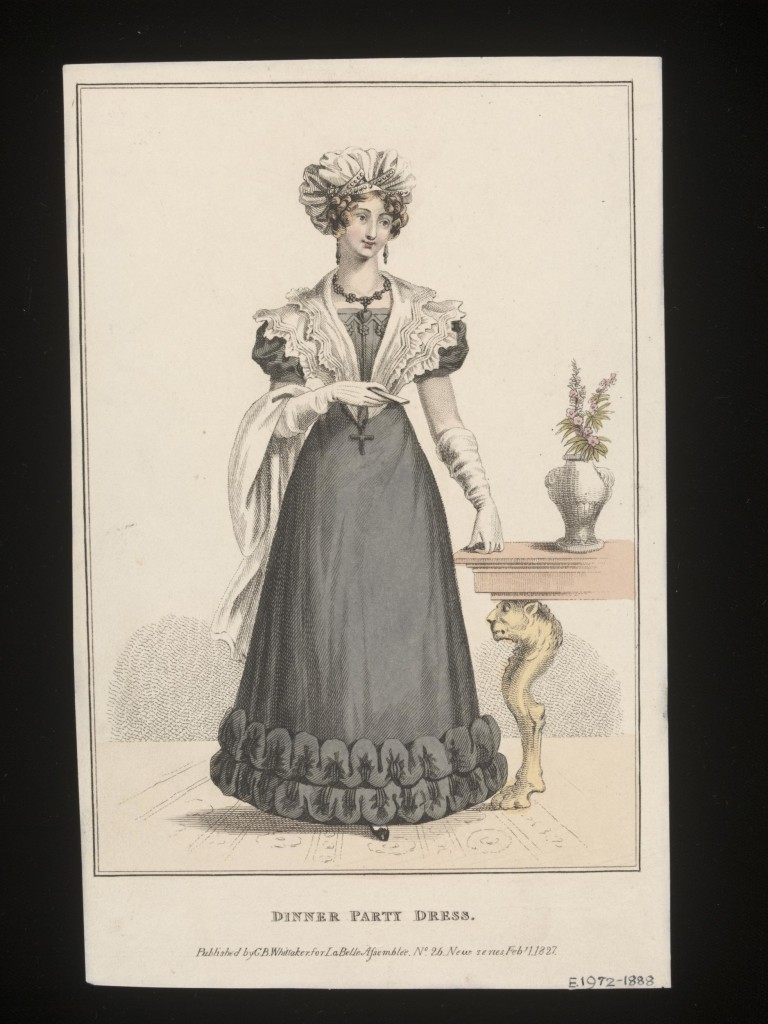
It is interesting to see the evolution of this dress from the previous one of 1809. There are many more opulent mourning elementsdepicted here, with careful attention to how the subject is wearing her necklace. The lady is wearing a dinner party dress with a lace collar and benching around the hem. She has a white shawl across her arm and also wears a white turban, an evolution of the white mourning cap. Silhouettes were starting to become larger in the skirt and the under bust cut had moved back down to the waist thecreate an hourglass figure. The crucifix is connected to a chain around her waist, while the floral necklace features a locket. Drop earrings match the set, demonstrating how the accessory was becoming part of a lady’s complete fashionable look. Accessories in this period also became larger, a trend that would see its peak c.1860 in jewels, as dresses grew larger and wider. Mourning as an industry was integrating more into daily fashionable identity.
White is on display here as being the predominant secondary colour. For half mourning, this is still fashionable wear for dinner parties,and also adapting to the new ethnic styles, seen in the turban. Deepest mourning was quite specific about its rules over non-reflective surfaces and as much light absorption as possible, but white and its introduction to daily mourning was quite acceptable. Note how the turban takes place of the cap, but still is an evolution.

White collar and trim adorn the lady, while the child wears the white mourning cap. This was at the peak of the neoclassical period, a time which established many of the customs and colours that would be retained for the following 19th century. The lady sitting at the table in this print by Thomas Webster wears a mourning cap and a large bracelet at her wrist. Bracelets are important in the presentation of mourning, due to the space on the wrist that they can accommodate. In the early 19th century, the miniature portrait was one of the more popular tokens of love and affection that a person could give. This became popular during the Napoleonic wars, where a soldier could have a pre-designed portrait (with uniform) quickly customised to their identity and given to a loved one. Clasps became bigger and more oval shaped, strung with pearls or hair. Worn for dinner parties, their lack of daily use and keepsake status has led many of them to exist to this day.
In the 19th century, black was still the standard of mourning, particularly for children over six, and highly required for girls. Boys would have worn white dresses trimmed with black until the age of breeching (four to six). Breeching was when a small boy wore dresses before wearing breeches or trousers and was considered more of a rite of passage, rather than an eventuality.
As children grew, there was a solid business for the creation of mourning costume, as the children outgrew what they wore. Even from the 17th century, a mourning gown could cost upwards of £5, which is an incredible sum for the child in mourning. Dyeing dresses was acceptable, particularly during the 19th century, making the denotation of mourning affordable for all classes of society.
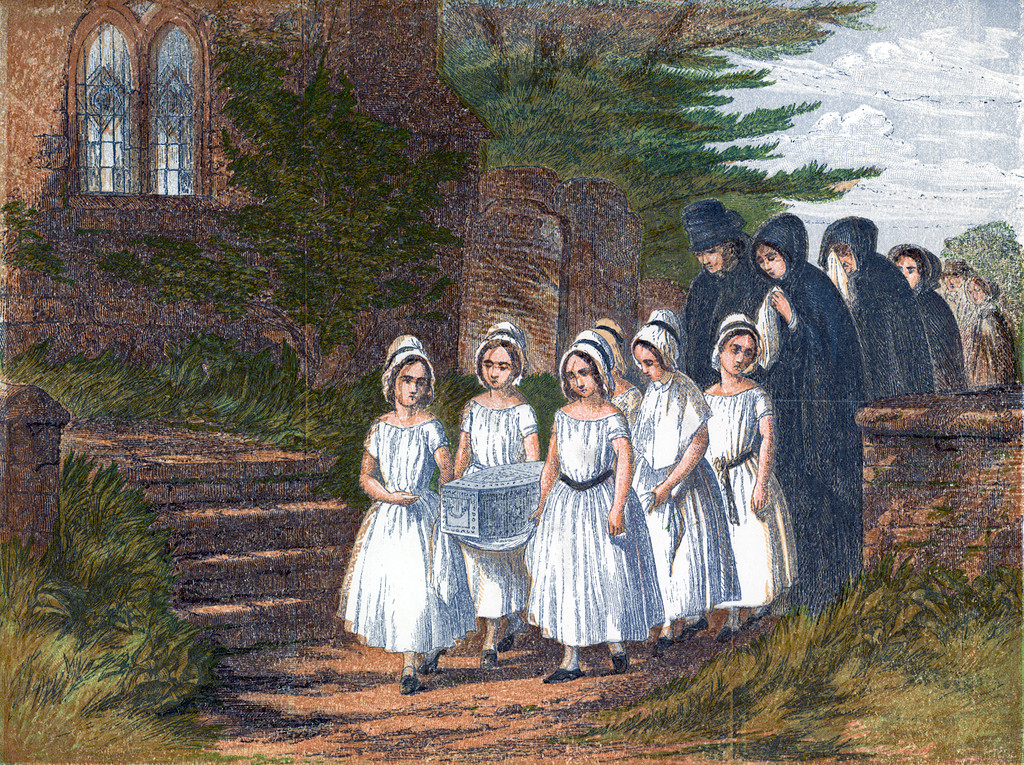
‘The Tolling Bell’, a hymn published by S.P.C.K in the 1840s, has an illustration of six girls carrying the coffin of an infant to the grave site. The girls are wearing white to denote the innocence and purity of the child in the same manner as white enamel would be used in a mourning ring.
“No sooner was my Lucy gone, than I caused Sally to be dressed in her frocks. I made her and Annie new caps, which I trimmed with rosettes of black love-ribbon, thus encouraging my sorrow” – The life of Mrs. Sherwood, (chiefly autobiographical) with extracts from Mr. Sherwoods journal during his imprisonment in France & residence in India by Sherwood, Mrs. (Mary Martha), 1775-1851; Kelly, Sophia, b. 1815, ed; Sherwood, Henry, 1777-1849
Mrs Sherwood, as a primary source, references how she approached mourning on the death of her daughter. There is clear indication here of the mourning cap and the black trimming which was added to existing dresses. While mourning entered fashion, it was still an expensive venture for a family. Utilising and revamping existing items was necessary when the household entered mourning, especially considering the expected length of the mourning period.

In the eyes of Victorian society, the death of a prostitute was considered the same as a child or an unmarried person. They were buried by friends and colleagues, with a hearse decorated with white plumes and ribands to indicate virginity.

“Victorian etiquette ruled that widows went into deep mourning (called First Mourning) for a year and a day after the death of their husband. Some sources advised that during this time only black handkerchiefs should be used. This advice varied, and a complete list of clothes needed for respectable First Mourning, published in the 1881 issue of Sylvia’s Home Journal included ‘Twelve handkerchiefs with black borders, for ordinary use, cambric’ and ‘Twelve of finer cambric for better occasions’. Decoration, in the form of black edging, took a number of forms from plain printed or woven borders to black embroidery, as in this example, and narrowed as mourning diminished.” – Victoria & Albert Museum
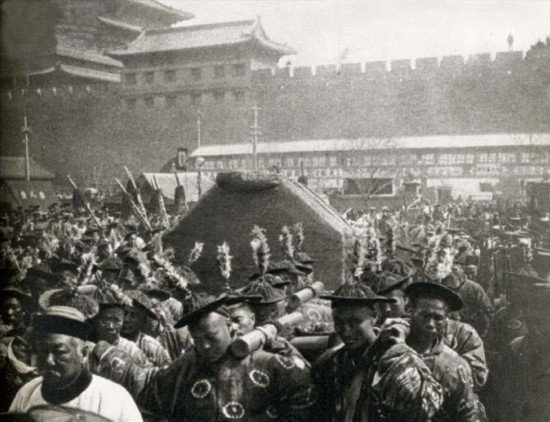
In cultures such as Chinese and Korean, the reverse of the colour is appropriate for mourning. Black is still an important colour to represent deepest mourning; however, there is a different approach to colour theory. In China, previous to the Five Elements Theory, where the spectrum of colours was expanded to black, white red, green and yellow, the Taoist belief was that there were only the opposite black and white colours, or the yin-yang. The symbol of white in this theory alludes to white being used for “mourning, contracting, withering, righteousness, pureness, confidence, intuition, strength, organization, death, ancestral spirits, ghosts, courage vs. sadness”. A white cloth is hung over the doorway of the deceased’s house and a gong placed to the left of the door, if the subject was male, or to the right if female. Children and daughter’s in-law wear black, as this is the deepest symbol of mourning, while grandchildren wear blue and sons-in-law wear white.
“Although the funeral rites are over, the period of mourning by the family continues for another 100 days. A piece of colored cloth is worn on the sleeve of each of the family members for 100 days to signify mourning: Black is worn by the deceased’s children, blue by the grandchildren and green by the great grandchildren. More traditional families will wear the pieces if cloth for up to three years. A period of mourning is not required if the deceased is a child or a wife.” – Chinaculture.org / Ministry of Culture of the People’s Republic of China
Wearing White
Purity, innocence and virginity; all the staples of a life untarnished and virtue kept. These were the concepts that defined the modern era and still remain today. Their representation in the colour of white is a simple way of symbolizing the virtue of a departed loved one . While not necessarily a realistic interpretation, it is the piety and memory of the person that must be retained, either in a person or in a family.

Love and loss connects people together, regardless of ecclesiastical ideology, society or time. Communities cannot evade death, so acknowledging it through basic symbolism is important. Black and white, yin and yang, night and day, all correlate with ancient cultural views on life and death, or being awake and asleep.
Between the 15th to the 20th centuries, white in fashion thrived in its symbolic message of purity, often amplifying the personal relation of the mourner to the deceased. Its message is a clear one, developing from the costume of early Christian widows and finally being understood in the modern era. New wealth through a merchant class could afford to propagate a style and the deaths of royalty and the popular allowed for the dissemination of ‘proper’ symbolic use.
White is still as relevant today as it was then. Love in weddings can be seen in the wearing of white for the bride, representing the same reasons as it would be for death. It is the memory of the occasion and the person that make it a powerful and relevant colour for purity, virginity and innocence. People who are treasured in memory are as untarnished as the colour of white itself, honouring the person with clarity, purity and love.




